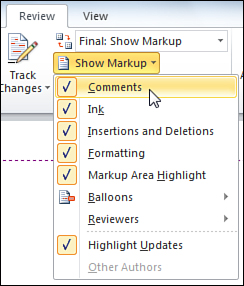2. Working with a Reviewer’s Comments
If someone else adds comments to one of your documents, you can view them, hide them, edit them, and delete them.
Navigating Comments
There’s no need to scroll or search a document to
find comments. Word can take you directly to a comment. Here’s how to
navigate the comments in a document:
1. | Open a document that contains comments, such as the one shown in Figure 3. In the figure, the document is shown in Print Layout view. The comments appear on the right side of the page.

|
2. | Click the Review tab.
|
3. | In the Comments group, click Next. Word highlights the first comment.
|
4. | Click Next again to jump to the next comment.
|
5. | From this point, click either Next or Previous to move from one comment to another.
|
|
You
can also view notes in a reviewing pane, which displays comments and
information about other changes in a list. To open a reviewing pane,
click Reviewing Pane (in the Tracking group); then click either
Reviewing Pane Vertical or Reviewing Pane Horizontal. To close the
pane, click the Close button at the right end of its title bar.
|
Hiding Comments
You can keep the comments in a document, but you
don’t always have to look at them. To hide comments from view, do the
following:
1. | Click the Review tab.
|
2. | In the Tracking group, click Show Markup. A drop-down menu of options opens, as shown in Figure 4.

|
3. | Click
Comments to clear its check mark. Word hides the comment bubbles, their
arrows, and the text highlighting associated with comments.
|
Hiding comments does not delete them from the document. To see the comments again, repeat the preceding steps.
Editing and Deleting Comments
You can edit and delete your own comments and comments from other people. Here’s how:
- To edit a
comment, click it and start editing. You can revise, cut, or copy the
comment’s text; paste text into the comment; and delete text from the
comment.
- To delete a comment (bubble and all), click it. Then do one of the following:
- In the Comments group, click Delete. (If you want to delete all
the comments from a document, click the Delete button’s drop-down
arrow, and then click Delete All Comments in Document.)
- Right-click the comment to open a shortcut menu; then click Delete Comment.
- You cannot delete a comment by pressing the Del key. Don’t ask me why, but it doesn’t work that way.